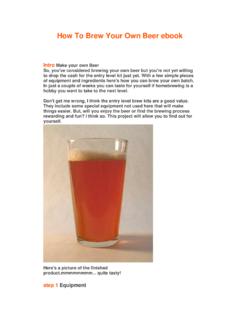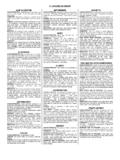Transcription of The Complete Beer Fault Guide v. 1 - Carolina …
1 The Complete BeerFaultGuidev. Thomas Barnes, 2011-2013 Permission is granted to reprint this Guide for personal or non-profit useIntroductionThis Guide is a summary of my research into sensorycharacteristics of beer . Information has been gleaned from anumber of sources, notably George Fix sPrinciples of BrewingScience, 2ndedition, but also a variety of online and academicsources. Even so, it is a work in progress. Eventually, it willinclude Complete information on every sensory descriptor listedon the Meilgaard Flavor Wheel, as well as other sensorydescriptors discovered by fermentation descriptors are listed in alphabetical order. Notethat some descriptors don t necessarily agree with informationpublished by the Detected In:Flavor, As:Bakingsoda,harsh,metallic,salty, Concentrations in beer : Flavor Wheel Number: is a proprietary blend of phosphate salts(mostly sodium phosphate) sold by Five Star Chemical whichclaims to reduce mash pH to buffer it at that levelregardless of starting pH.
2 Under certain conditions, notablywhen using highlyalkaline water, or if you use excess amounts,it can affect flavor and Alkaline and Appropriate? (Rose-like)Detected In:Aroma, Concentrations in beer :? Threshold:? Wheel :See In:Aroma, As:Aldehydic, bready,bruised apples,cidery,fruity, grassy, green apple, green leaves, latex paint(AKAemulsion paint),raw apple skin, rough. Sometimes mistakenfor cellar-like, musty or sour notes, sweet apple esters and/oracetic sourness (and vice-versa).Typical Origins:Yeast activity, Microbial Concentrations in beer :2-15 Threshold:5-20 6-8 g/ml it isperceived as a fruity flavor. At higher levels it has a distinctive green apple aroma flavor and Flavor Wheel :Acetaldehyde is the most important aldehyde(carbonyl compound)in beer , although there are isfound in all beer , although detectable levels areconsidered to be a defect in most beer styles.
3 * It is typicallyproduced as a precursor to ethanolproduced during fermentation:glucose is metabolized intopyruvic acidwhich is then converted to acetaldehyde and then toethanol. During fermentation some acetaldehyde escapes fromthe yeast cell. During the final phases of fermentation, the yeastscavenges free acetaldehyde and finishes converting it.* In young beer or fermenting wort, acetaldehyde levelsrange from 20-40 mg/l, decreasing to 8-10 mg/l in finished beer .*Oxidation of finished beer might convert ethanol backinto this case, acetaldehyde is usuallyaccompanied by other oxidation and/or age-related defects.*The combination of bacterial action and oxidationcanreduce acetaldehyde to acetic acid (vinegar) due to the chemicalreaction of ethanol and this case, acetaldehydeis usually accompanied by acetic acid and other is indicative of infection byAcetomonas, Aldehydes Found in BeerAldehydeDescriptorDetectablerange3-M ethylbutanalUnripe apples2-20 mg/lBenzaldeydeBitter almonds, burntalmonds, , , , By:* Yeast management:Yeast strain (highlyflocculent strains).
4 Poor yeast health. at temperature too cool for fermentation. Removing yeastfrom wort prematurely ( , fining, filtering, crash coldconditioning). Insufficient conditioning pressure (whether atmospheric or liquid pressure-although this is mostly a problem for large breweries, nothomebrewers).*Aeration of green beerduring conditioning orpackaging.*Bacterial infection byZymomonasorAcetobacterspecies(but usually accompanied by other off-flavors in suchcases, such as sulfur compounds or acetic acid, respectively).* Acetaldehyde concentrations are increased by rapidfermentation, higher fermentationtemperatures and increasedyeast cell count, although these factors also promote reduction Avoid orControl:* Proper Yeast Management:Properfermentation temperature.
5 Longer fermentation and/orconditioning times. Proper yeast health/quality. Proper yeaststrain. Proper pitching rate (at least quarts per 5 gal. for ale,more for lager and high gravity beers). Diacetyl rest at ~50 Ffor 1-3 days at end of lagering yeastconcentration during conditioning period.(Also see VDK formore detailed discussion of diacetyl rests.)* Reduce headpressure during fermentation and conditioning to allowacetaldehyde to blow off. * Avoiding aeration of green beerorfermenting wort. *Proper sanitation to avoid bacterial infection.* Proper packaging and storage. Oxygen introduced duringpackaging can oxidize alcohol back into acetaldehydes,especially when catalyzed by heat and light.
6 * Scavenging of acetaldehyde by yeast is increased bypromoting vigorouslate primary andsecondary fermentation, byconditioning at warmer temperatures and increasing yeast cellcount during late primary and secondary fermentation ( , byadding more yeast or by rousing existing yeast).When Are Acetaldehyde Notes Appropriate?:For moststyles of beer , detectable level of acetaldehyde is a Fault . Theexception is that LiteandStandard American Lagersmay havevery low levels of is because Budweiser hasvery slight acetaldehyde notes,since Anheuser-Busch usesbeechwood slatsin their conditioning tankstoencourage theyeast to flocculate and settle prematurely,before it reducesallthe acetaldehyde to (Sour)Detected In:Aroma, As:Acidic, cidery,lingering sourness,sharpsourness,sour,sour apples,tangy, tart, Origins:Microbial Concentrations in beer :30-200 Threshold:130 Flavor Wheel :Acetic acid is one of the morecommon sour( ) tastes found in beer .
7 It naturally occurs at low levels in allbeers as a result of yeast activity during fermentation, althoughdetectable levels are considered to be a defect in most beerstyles.*Acetic acid is volatileand has a relatively low perceptionthreshold,so it caneasilybe detected in a beer s aroma as wellasinits flavor.* High levels of acetic acid are caused by oxidation ofethanol by bacteria; mostcommonlyAcetobacterspecieswhichprodu ce a white pellicle orfilm on top of the beerin theconditioning high levels of acetic acid. These infectionsproduce aslimy, ropy film on top of the beer . Both of these infections taketime to develop andcanonly proceedin the presence of (typically Zymomonasmobilus)alsoproduceacetic acid,along with esters, acetaldehyde and sulfurdioxide.
8 Yeasts of theKloeckeraandBrettanomycesfamilies canalso produce acetic acid, in conjunction withother distinctiveoff-flavors ( , leathery, sweaty). Infections by these organismscan occur in anaerobic conditions, usually at ale fermentationtemperatures or By:*Inoculationwith bacteria or wild yeast. *Exposinggreen or packaged beerto Avoid or Control:* Proper yeast management:Chooseappropriate yeast strain. Reduce percentage of adjunct sugars inthe beer . Pitch correct amount of yeast ( qt per 5gallons) for optimum yeast health and to minimize lag time.*Practice proper sanitation. Thoroughly clean all cold-sideequipment before sanitizing it. Don t use cold side equipmentwhich can t be sanitized ( , wooden or scratched plasticutensils/containers).
9 * Don t use the same equipment for regularand standard beers unless it can be completely sanitized;especially avoid using soft plastic items for both. * Don texposegreenor packagedbeerto IsAceticSourness Appropriate?:Low levels ofacetic sourness are expected in Belgian sour ales(Flanders Red,Flanders Brown, Lambics).AcetoneDetected In:Aroma, flavor, mouthfeel(as warming).Described As:Nail polish remover, solvent. Solventy orharsh Origins:Yeast activity, process Concentrations in beer :? Threshold:? Wheel Number:0123 Discussion:See In:Aroma, As:Pungent aroma, sharpness of taste, Origins:Bacterial Concentrations in beer :? Threshold:? Wheel Number:0900 Discussion:See Acetic (Sour), Lactic (Sour) or In:Aroma, flavor, mouthfeel(as warming).
10 Described As:The general effect of ethanol and Origins:Yeast Concentrations in beer :?BeerFlavor Wheel Number:0110 Discussion:See Ethanol, Fusel Alcohol and (Bitter)Detected In:Flavor, mouthfeel, As:Biscuity, bitter, caustic, chalky, detergent-like,drying, harsh, line-cleaner, lye, mineral-like, salty, sodiumbicarbonate, alkalinity might affect perceptionof hop bitterness and malt character before it becomes obviouson its Tip: Green Applesand ButterAcetaldehyde and Diacetyl often appear together in thesame beer . Both chemicals are produced during the lagphase of fermentation andboth should be metabolizedby theyeast in thelate fermentation/dormancy appleand butter aromas and flavors might arise inbeers,especially lagers, where the yeast has precipitated or beenfiltered prematurely, or otherwise produced a lot ofacetaldehyde and diacetyl initially and thendidn t have theability to clean it up later ( , weak or mutant yeast).








